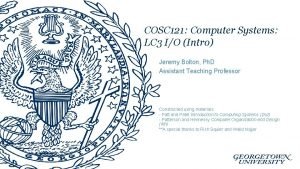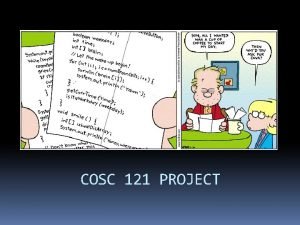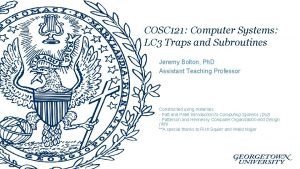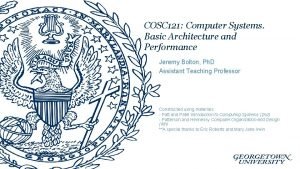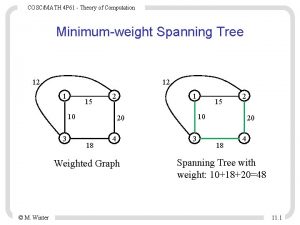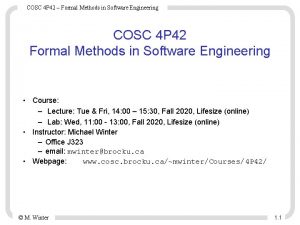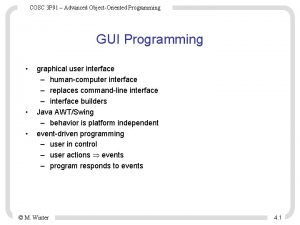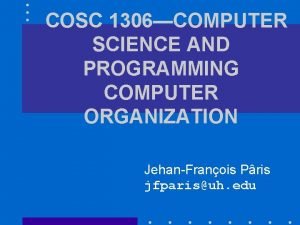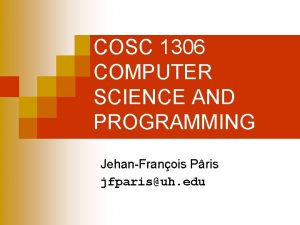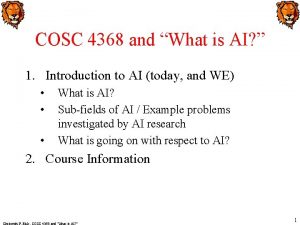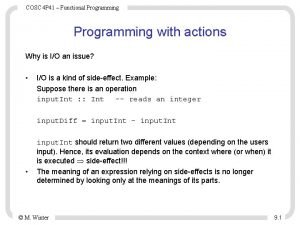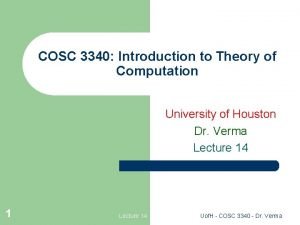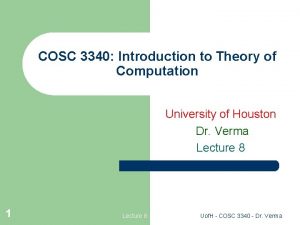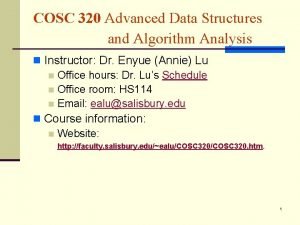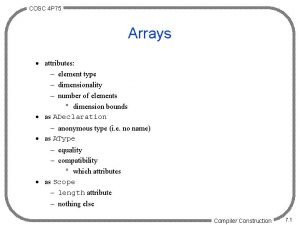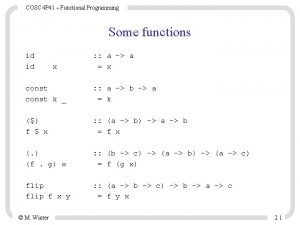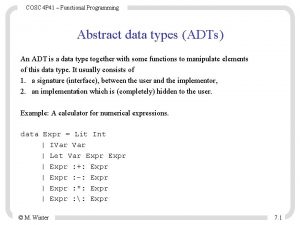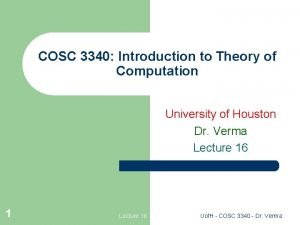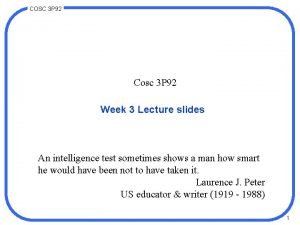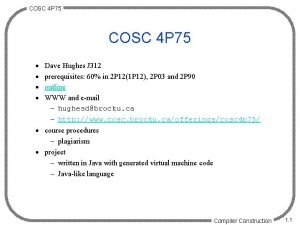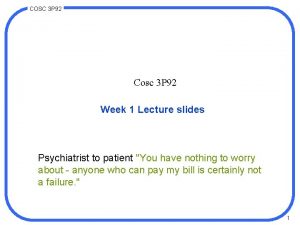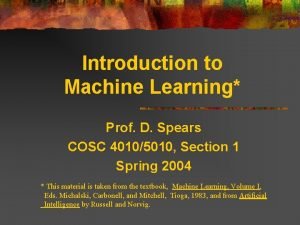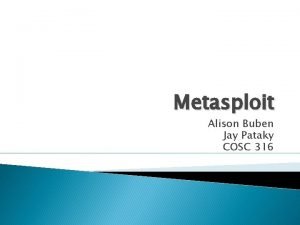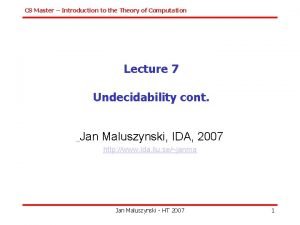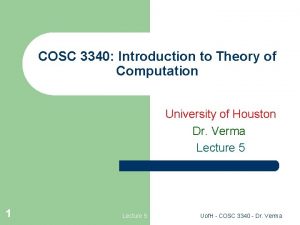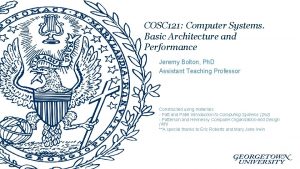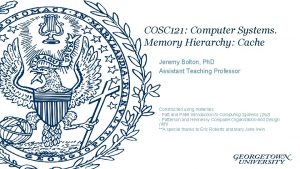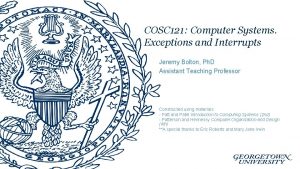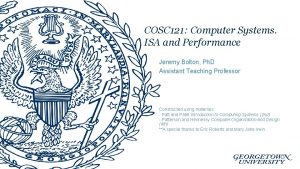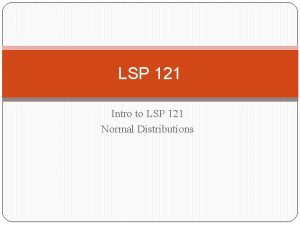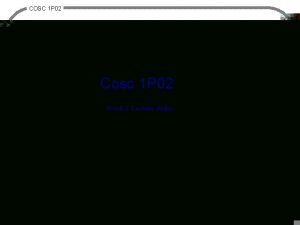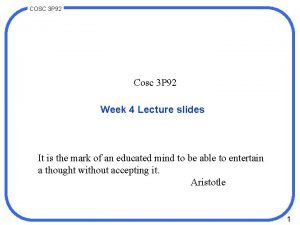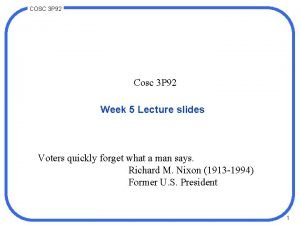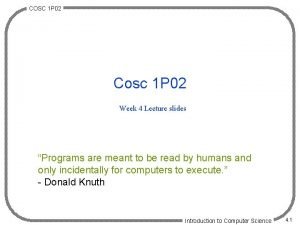COSC 121 Computer Systems LC 3 IO Intro

































- Slides: 33

COSC 121: Computer Systems: LC 3 I/O (Intro) Jeremy Bolton, Ph. D Assistant Teaching Professor Constructed using materials: - Patt and Patel Introduction to Computing Systems (2 nd) - Patterson and Hennessy Computer Organization and Design (4 th) **A special thanks to Rich Squier and Walid Najjar

Notes • Read PP. 8 – PP. 9 • Complete HW #4 • Project #1 Posted (in parts) – Supplemental files

Outline • Programming in Overview of – I/O in LC 3 • Keyboard • Monitor – Polling vs Interrupts – Operating System Intro

This week … our journey takes us … COSC 121: Computer Systems Application (Browser) Operating System (Win, Linux) Compiler Software Hardware Assembler Drivers Processor Memory I/O system COSC 255: Operating Systems Instruction Set Architecture Datapath & Control Digital Design Circuit Design transistors COSC 120: Computer Hardware

PP. 8 I/O

I/O: Connecting to Outside World • So far, we’ve learned how to: – compute with values in registers – load data from memory to registers – store data from registers to memory • But where does data in memory come from? • And how does data get out of the system so that humans can use it? 8 -6

I/O Basics • Definitions – Input • transfer data from the outside world to the computer: keyboard, mouse, scanner, bar-code reader, etc. – Output • transfer data from the computer to the outside: monitor, printer, LED display, etc. – Peripheral: any I/O device, including disks. • LC-3 supports only a keyboard and a monitor 8 -7

I/O: Connecting to the Outside World • Types of I/O devices characterized by: – behavior: input, output, storage • input: keyboard, motion detector, network interface • output: monitor, printer, network interface • storage: disk, CD-ROM – data rate: how fast can data be transferred? • keyboard: 100 bytes/sec • disk: 30 MB/s • network: 1 Mb/s - 1 Gb/s 8 -8

Device Registers • I/O Interface – Through a set of Device Registers: • Status register (device is busy/idle/error) • Data register (data to be moved to/from device) – The device registers have to be read/written by the CPU. • KBSR[15] - keyboard ready (new character • LC-3 available) • KBDR: keyboard data register • KBSR: keyboard status register • DDR: display data register • DSR: display status register • KBDR[7: 0] - character typed (ASCII) • DSR[15] - monitor ready • DDR[7: 0] - character to be displayed (ASCII) LC-3 8 -9 KBSR DSR KBDR DDR

Communication with I/O devices Processor Communication • Each IO device will have a controller to facilitate communication. • Communication is facilitated through a shared medium Memory - I/O Bus Main Memory I/O Controller Disk I/O Controller Monitor – Memory or direct lines I/O Controller Network • Interaction with an I/O device is restricted by OS (more to come)

Memory-Mapped vs. I/O Instructions • Special I/O Instructions – Read or write to device registers using specialized I/O instructions. • Memory Mapped I/O – Use existing data movement instructions (Load & Store). – Map each device register to a memory address (fixed). – CPU communicates with the device registers as if they were memory locations. • LC-3 – Uses memory mapped I/O: 8 - 11 x. FE 00 x. FE 02 XFE 04 XFE 06 XFFFE KBSR KBDR DSR DDR MCR Keyboard Status Register Keyboard Data Register Display Status Register Display Data Register Machine Control Register

Memory-Mapped vs. I/O Instructions • Instructions – designate opcode(s) for I/O – register and operation encoded in instruction • Memory-mapped – assign a memory address to each device register – use data movement instructions (LD/ST) for control and data transfer 8 -12

Synchronizing CPU and I/O • Problem – Speed mismatch between CPU and I/O: • CPU runs at up to ~ 2 GHz, while all I/O is much slower. – Example : Keyboard input is both slow, and irregular. – We need a protocol to keep CPU & KBD synchronized. • Two possible solutions: – Polling (handshake synchronization) – Interrupt-driven I/O 8 - 13

Transfer Timing • I/O events generally happen much slower than CPU cycles. • Synchronous – data supplied at a fixed, predictable rate – CPU reads/writes every X cycles • Asynchronous – data rate less predictable – CPU must synchronize with device, so that it doesn’t miss data or write too quickly 8 -14

Transfer Control • Who determines when the next data transfer occurs? • Polling – CPU keeps checking status register until new data arrives OR device ready for next data – “Are we there yet? ” • Interrupts – Device sends a special signal to CPU when new data arrives OR device ready for next data – CPU can be performing other tasks instead of polling device. – “Wake me when we get there. ” 8 -15

Polling v/s Interrupts (Who’s driving? ) • Polling: CPU in charge – CPU checks the ready bit of status register (as per program instructions). • If (KBSR[15] == 1) then load KBDR[7: 0] to a register. – If the I/O device is very slow, CPU is kept busy waiting. • Interrupt: peripheral in charge – Event triggered - when the I/O device is ready, it sets a flag called an interrupt. – When an interrupt is set, the CPU is forced to an interrupt service routine (ISR) which services the interrupting device. – There can be different priority levels of interrupt. 8 - 16

LC-3 • Memory-mapped I/O (Table A. 3) Location I/O Register Function x. FE 00 Keyboard Status Reg (KBSR) Bit [15] is one when keyboard has received a new character. x. FE 02 Keyboard Data Reg (KBDR) Bits [7: 0] contain the last character typed on keyboard. x. FE 04 Display Status Register (DSR) Bit [15] is one when device ready to display another char on screen. x. FE 06 Display Data Register (DDR) Character written to bits [7: 0] will be displayed on screen. • Asynchronous devices – synchronized through status registers • Polling and Interrupts – the details of interrupts will be discussed in Chapter 10 8 -17

Input from Keyboard • When a character is typed: – its ASCII code is placed in bits [7: 0] of KBDR (bits [15: 8] are always zero) – the “ready bit” (KBSR[15]) is set to one – keyboard is disabled -- any typed characters will be ignored** keyboard data 15 8 7 0 KBDR ready bit • When KBDR is read: – KBSR[15] is set to zero – keyboard is enabled 8 -18 1514 0 KBSR

Basic Input Routine POLL NO Polling new char? YES read character 8 -19 LDI R 0, KBSRPtr BRzp POLL LDI R 0, KBDRPtr. . . KBSRPtr. FILL x. FE 00 KBDRPtr. FILL x. FE 02

Output to Monitor • When Monitor is ready to display another character: – the “ready bit” (DSR[15]) is 15 set to one 8 7 output data 0 DDR 1514 ready bit 0 DSR • When data is written to Display Data Register: – DSR[15] is set to zero – character in DDR[7: 0] is displayed – any other character data written to DDR is ignored (while DSR[15] is zero) 8 -20

Basic Output Routine NO Polling screen ready? YES write character 8 -21 POLL LDI R 1, DSRPtr BRzp POLL STI R 0, DDRPtr. . . DSRPtr DDRPtr . FILL x. FE 04. FILL x. FE 06

Simple Polling Examples Why use pointers here? START LDI BRzp LDI BR A. FILL B. FILL R 1, A ; Loop if Ready not set START R 0, B ; If set, load char to R 0 NEXT_TASK x. FE 00 ; Address of KBSR x. FE 02 ; Address of KBDR Input a character from keyboard START LDI BRzp STI BR A. FILL B. FILL R 1, A ; Loop if Ready not set START R 0, B ; If set, send char to DDR NEXT_TASK x. FE 04 ; Address of DSR x. FE 06 ; Address of DDR Output a character to the monitor 8 - 22

Example: Print a string LOOP LP 2 STR DONE 8 - 23 LEA R 1, STR ; Load address of string LDR R 0, R 1, #0 ; get next char to R 0 BRZ DONE ; string ends with 0 LDI R 3, DSR ; Loop until MON is ready BRzp LP 2 STI R 0, DDR ; Write next character ADD R 1, #1 ; Set address to next char BR LOOP. STRINGZ "Char String" HALT

Interrupt-driven I/O • Generating the interrupt signal – The I/O device must want to request service. – The device must have the right to request service, – This request must be more urgent than the processor’s current task. • Handling the interrupt signal – We will wait untile we understand stacks before getting to this. 8 - 24

Interrupt-Driven I/O • External device can: (1) Force currently executing program to stop; (2) Have the processor satisfy the device’s needs; and (3) Resume the stopped program as if nothing happened. • Why? – Polling consumes a lot of cycles, especially for rare events – these cycles can be used for more computation. – Example: Process previous input while collecting current input. (See Example 8. 1 in text. ) 8 -25

Generating the Interrupt: More to come later on … • Using the Status Register – The peripheral sets a Ready bit in SR[15] (as with polling) – The CPU sets an Interrupt Enable bit in SR[14] – These two bits are anded to set the Interrupt. • In this way, the CPU has the final say in who gets to interrupt it! 8 - 26

Testing for Interrupt Signal • CPU looks at signal between STORE and FETCH phases. • If not set, continues with next instruction. • If set, transfers control to interrupt service routine. F NO Transfer to ISR YES interrupt signal? D EA OP EX More details later! S 8 -27

Appendix: Jeremy Bolton, Ph. D Assistant Teaching Professor Constructed using materials: - Patt and Patel Introduction to Computing Systems (2 nd) - Patterson and Hennessy Computer Organization and Design (4 th) **A special thanks to Rich Squier and Walid Najjar

Keyboard Echo Routine • Usually, input character is also printed to screen. – User gets feedback on character typed and knows its ok to type the next character. POLL 1 LDI BRzp LDI POLL 2 LDI BRzp STI R 0, KBSRPtr POLL 1 R 0, KBDRPtr R 1, DSRPtr POLL 2 R 0, DDRPtr NO YES read character . . . KBSRPtr KBDRPtr DSRPtr DDRPtr 8 -29 . FILL x. FE 00 x. FE 02 x. FE 04 x. FE 06 new char? NO screen ready? YES write character

Priority • Every instruction executes at a stated level of urgency. • LC-3: 8 priority levels (PL 0 -PL 7) – Example: • Payroll program runs at PL 0. • Nuclear power correction program runs at PL 6. – It’s OK for PL 6 device to interrupt PL 0 program, but not the other way around. • Priority encoder selects highest-priority device, compares to current processor priority level, and generates interrupt signal if appropriate. 8 -30

Device Priority 8 - 31

Simple Implementation: Memory-Mapped Input Address Control Logic determines whether MDR is loaded from Memory or from KBSR/KBDR. 8 -32

Full Implementation of LC-3 Memory-Mapped I/O Because of interrupt enable bits, status registers (KBSR/DSR) must be written, as well as read. 8 -33
 Cosc 121
Cosc 121 Cosc 121
Cosc 121 Cosc 121
Cosc 121 Lc3 trap
Lc3 trap Cosc 121
Cosc 121 Cosc 4p61
Cosc 4p61 Cosc 4p42
Cosc 4p42 Cosc 3p91
Cosc 3p91 Cosc 1306
Cosc 1306 Cosc 1306
Cosc 1306 Cosc 4368
Cosc 4368 Cosc 4p41
Cosc 4p41 Cosc 4p41
Cosc 4p41 Cosc
Cosc Cosc 3340
Cosc 3340 Cosc 320
Cosc 320 Cosc parameters
Cosc parameters Cosc function
Cosc function Cosc 4p41
Cosc 4p41 Cosc 3340
Cosc 3340 8088 pinout
8088 pinout Cosc 1p02
Cosc 1p02 Cosc 2p12
Cosc 2p12 Cosc 3p92
Cosc 3p92 Cosc 3p92
Cosc 3p92 Cosc -cos d
Cosc -cos d Cosc 1306
Cosc 1306 Cosc 3p94
Cosc 3p94 Cosc 101
Cosc 101 Introduction to the theory of computation
Introduction to the theory of computation Cosc 3340
Cosc 3340 Psalm 121 1-3
Psalm 121 1-3 Psal 121
Psal 121 Lmt121
Lmt121
